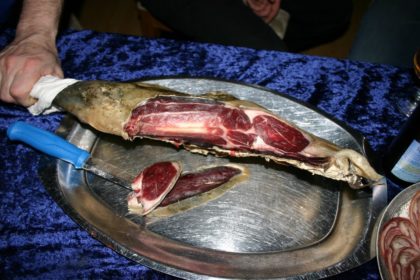
Journalist Dan Saladino explores the world’s endangered foods in his new book Eating to Extinction: The World’s Rarest Foods and Why We Need to Save Them. He argues that the world could lose culinary diversity. “The story of these foods, and the way in which they’re presented in the book,” says Saladino, from wild foods associated with hunters and gathers, to cereals, vegetables, meats and more, “is really the story of us and our own evolution.”
A review of Saladino’s book in Smithsonian Magazine shares 10 of the world’s rarest foods — five of them fermented. These rarities include:
- Skerpikjøt (Faroe Islands, Denmark): Dried and fermented mutton made from the shanks and legs of sheep. It ferments in wooden sheds called hjallur, which have vertical slats that allow space for the salty sea wind to blow in.
- Salers cheese (Auvergne, France): One of the world’s oldest raw milk cheeses made from the milk of Salers cows. The semi-hard cheese is made with varying fermentation lengths, which change the flavor.
- Qvevri wine (Georgia): Winemakers fill the egg-shaped terracotta pots called qvevri with grape juice, skins and stalks, then bury the pots underground. The steady temperatures and the pot’s shape allows even fermentation.
- Ancient Forest Pu-Erh Tea (Xishuangbanna, China): The fermented tea is made from wild tea leaves that grow in China’s southwestern Yunnan province. The leaves are sun-dried, cooked, kneaded, then formed into solid cakes and fermented for months (or years).
- Criollo Cacao (Cumanacoa, Venezuela): The world’s rarest type of cacao, it represents less than 5% of the cocoa production on the planet. The bean lacks bitterness, but is difficult to grow.
Read more (Smithsonian Magazine)
